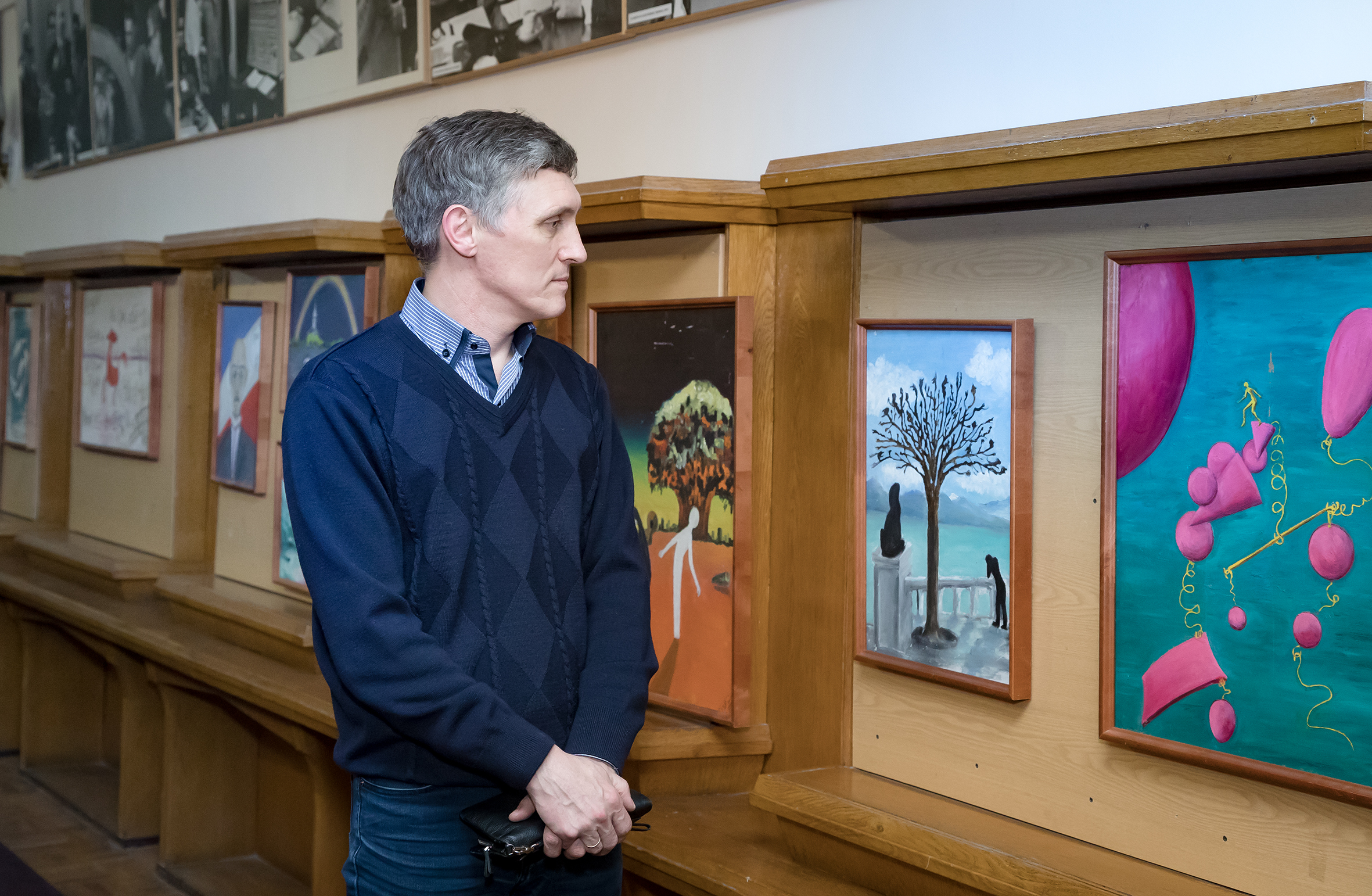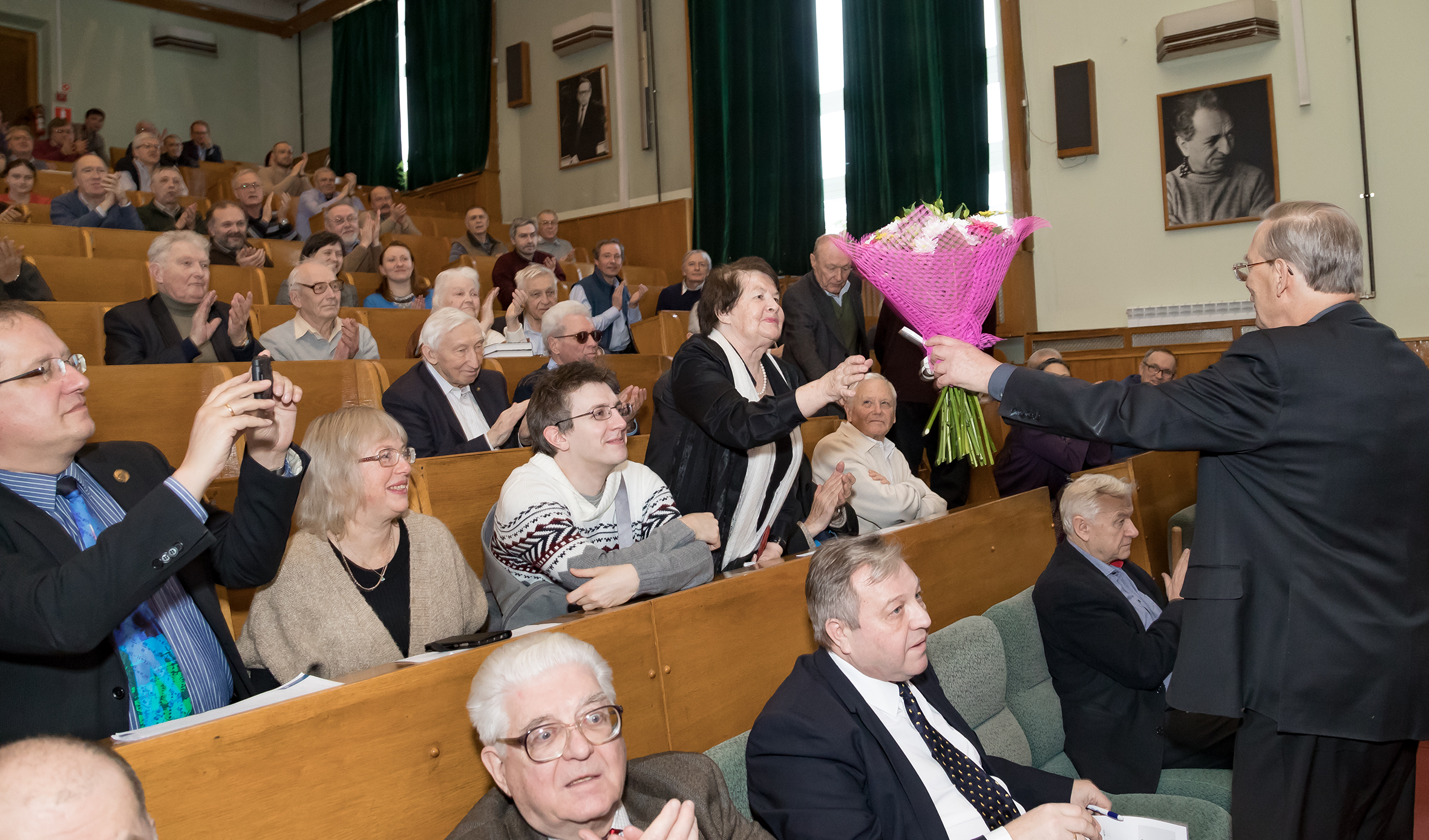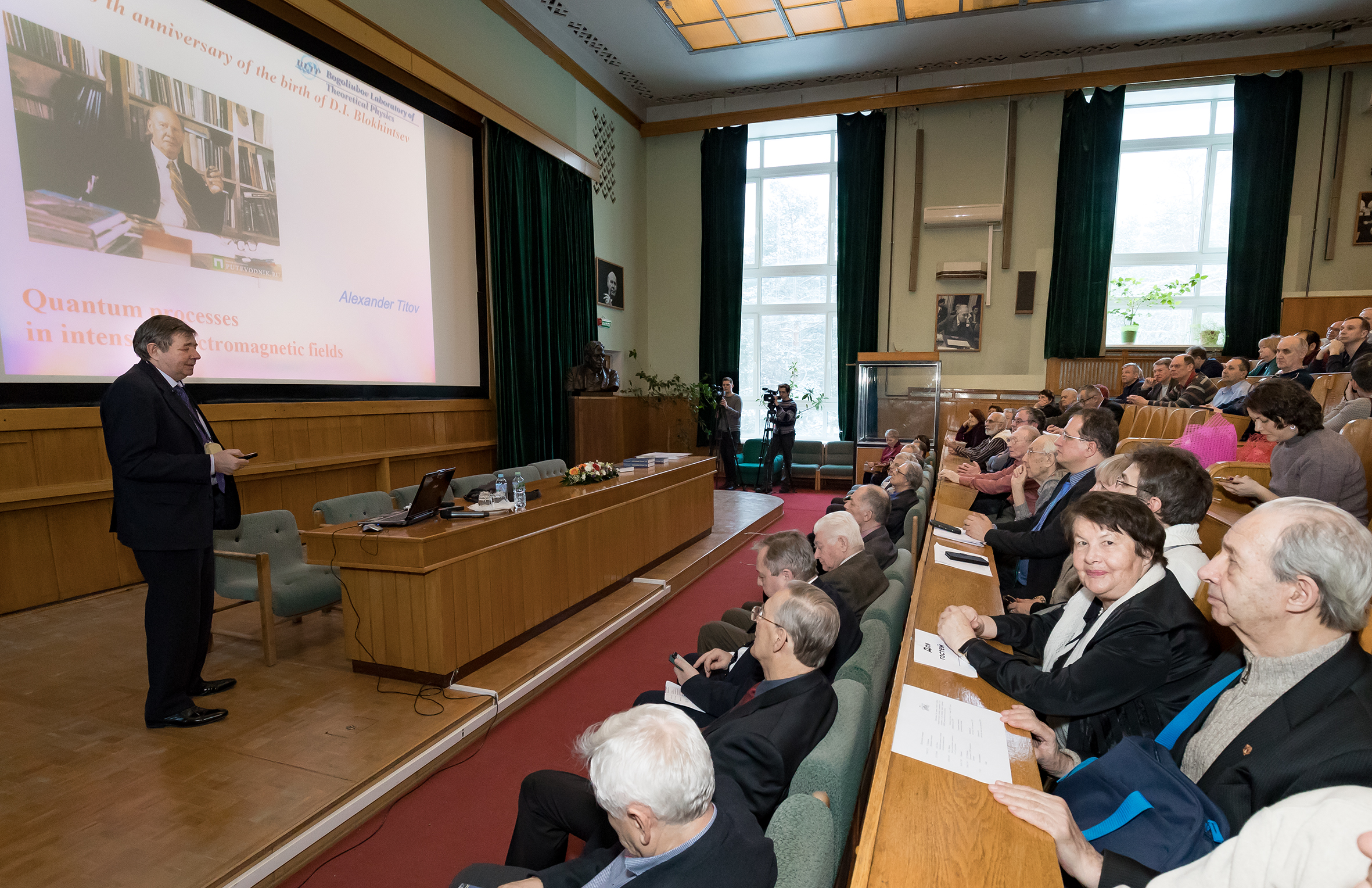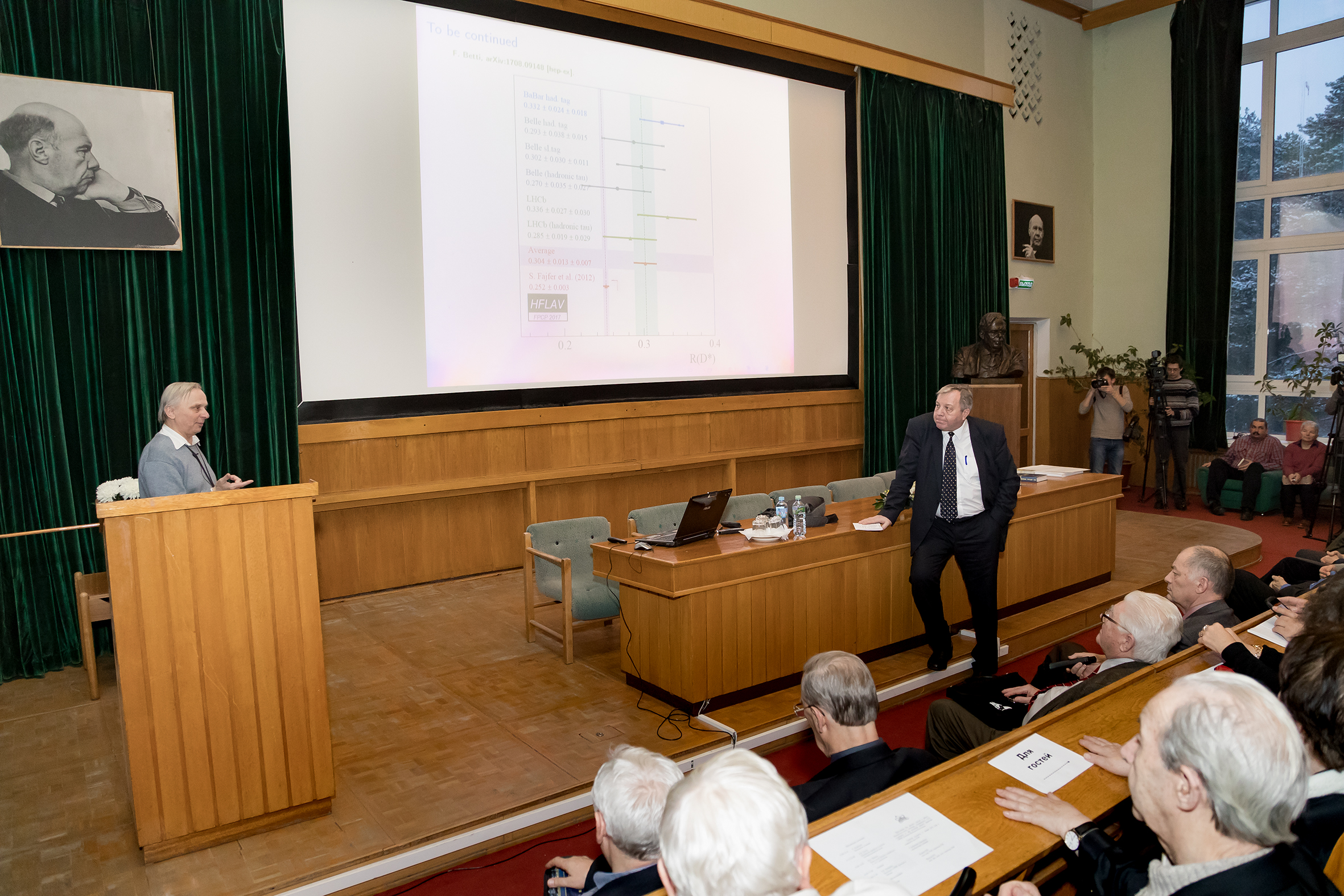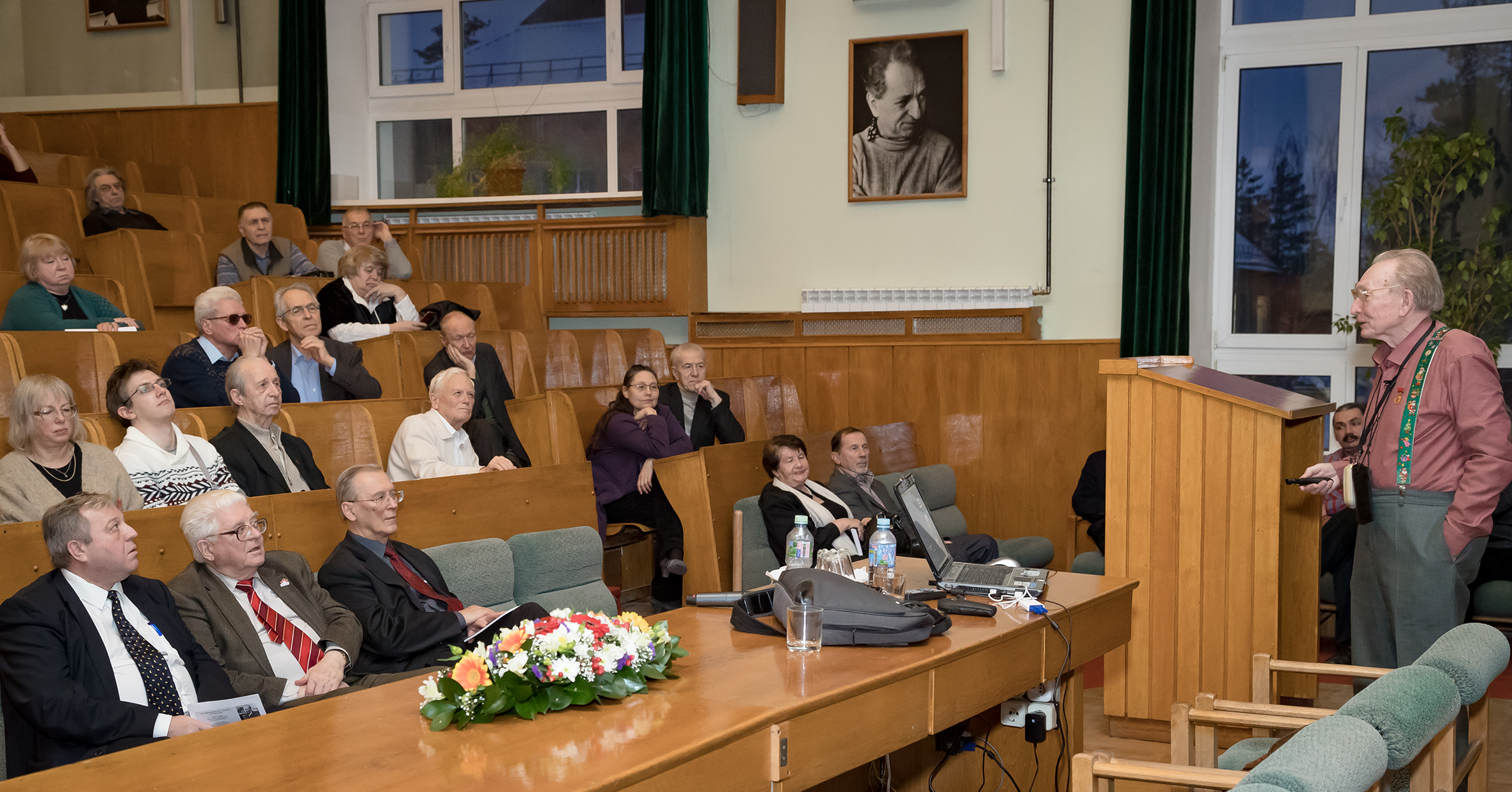Their names are in the history of science
News, 16 January 2018
Dmitry I. Blokhintsev in memories and books, in art and cinema
The joint seminar of JINR held on 11 January 2018 in the Conference Hall of the Bogoliubov Laboratory of Theoretical Physics was devoted to the 110th anniversary of the birth of Dmitry I. Blokhintsev. The seminar was preceded by flower laying at the bas-relief of Dmitry Blokhintsev next to the SINNP MSU branch that was established in Dubna by the first JINR Director. Other anniversary events include books exhibition and an event devoted to the memory of D.Blokhintsev that will be held on 18 January 2018 at 6:00 PM in the Blokhintsev Universal Public Library of JINR, and exhibition of D.Blokhintsev’s paintings arranged in the lobby near the Conference Hall of BLTP.
The seminar was opened by Director of the Frank Laboratory of Neutron Physics V. N. Shvetsov who organized the seminar jointly with Director of the Bogoliubov Laboratory of Theoretical Physics D. I. Kazakov. JINR Director V. A. Matveev in the opening remarks noted valuable services of D. I. Blokhintsev for development of the Soviet science and technologies. His services were awarded with the titles Hero of Socialist Labor (1956), the Lenin Prize (1957), the Stalin (1952) and the USSR State Prizes (1971). He was one of the founders of the Institute of Physics and Power Engineering (1947—1956) and JINR (1956 – 1965). The scientist was Member of the Bureau of Nuclear Physics of the USSR AS (1971 – 1979), President of IUPAP (1966 – 1969), Member of the Higher Attestation Commission under the USSR Council of Ministers, Advisor to the Scientific Council of the Secretary-General of the United Nations (since 1967).
V. A. Matveev warmly greeted relatives of D. Blokhintsev who were invited to the seminar, handed flowers to his daughter Tatyana and granddaughter Olga. D. I. Blokhintsev, one of the founders of JINR, was among the constellation of pioneers the Institute is obliged to for its creative atmosphere and brilliant scientific achievements. In particular, under D. I. Blokhintsev’s direction the set of pulse fast reactors was constructed in FLNP. His scientific works were devoted to the solid-state theory, semiconductor physics, optics, acoustics, quantum mechanics and quantum electronics, nuclear physics, theory of nuclear reactors, quantum field theory, elementary particle physics, philosophical and methodological issues of physics. “Life and creative works of D. I. Blokhintsev are an excellent model for bringing up our scientific youth,” JINR Director ended his presentation.
Scientific programme of the seminar was comprised of reports by A. I. Titov “Quantum processes in intensive electromagnetic fields” and M. A. Ivanov “Search for new physics in processes with b → cl vl transitions” in which the reporters demonstrated how Blokhintsev’s ideas are developed now in BLTP.
The theme “Blokhintsev and BLTP: past and future” was illustrated in the report by E. P. Shabalin. The report, rich in historical photos (it is even possible to name E.P. Shabalin a co-author of the FLNP photo chronicle by Yury Tumanov), explained why the names of Dmitry I. Blokhintsev and Ilya M. Frank are closely interconnected in the FLNP history.
The colleagues and students of D. I. Blokhintsev including Academician L. I. Ponomaryov (Kurchatov Institute), Professor A. V. Efremov (BLTP JINR), Professor R. N. Faustov (ITEP), Professor V. V. Nesterenko (BLTP JINR) shared their memories about him. Moreover, the film prepared by TV channel “Dubna” to the 100th anniversary of the scientist was shown to the seminar attendants. The JINR Publishing Department issued a short biography of the scientist called “The man of Renaissance” for the event. The books were gifted to the seminar participants. The authors of the book are A. A. Rastorguev and E. P. Shabalin. The personality of D. I. Blokhintsev is reflected in documents, photos and his own utterances. These are some memories of Dmitry Blokhintsev collected in the book:
* * *
January 1969. The USA, Miami, Rochester. A huge banquet hall is full of scientists who came to the conference on high-energy physics. A boring presentation by Chairman of the Atomic Commission, some other professors’ reports with jokes about quantum mechanics…then my turn comes. I knew that boredom would not be welcomed. A USSR representative, my rhetoric would be appreciated even less if my report were “empty”.
Ladies and gentlemen! In 1957 we needed about 20 hours to fly to your continent. Now, we need only half of it. I was thinking during the flight that we, all people of our planet, are passengers on a small space ship flying in dark space. I should remind you that no one can know where and from where we are flying. It is silly and senseless to argue in such a situation. That is why I propose a toast for cooperation in the field of human knowledge development and for peace and friendship in our space ship named the Earth.
* * *
In the mid 1950s, it was negotiated to construct the reactor of steady neutron flow in Obninsk for experiments in a neutron beam mostly for neutron spectroscopy. This idea seemed to be absurd: to construct a high-energy reactor and use then only a small part of this power in the form of short pulses sent by a beam shutter…Isn’t it more useful to make the reactor work by pulses causing chain reactions in it? … The enabling mechanism I suggested was very simple: reactivity modelling was supposed to be implemented by rotation of a disk with fission material (uranium-235). Thus, the construction of the reactor is the following: it should consist of two parts – the major part, an active part A, is static; another part B is fixed in fast rotating disk. When B while rotating goes by A, the reactor becomes overcritical, a powerful chain reaction is caused that, however, stops quickly as far as B moves away from A. Participants of the discussion highly appreciated this idea.
* * *
Following the presentation by D. I. Blokhintsev at the All-Union Conference on Philosophical Problems of Modern Natural Science: “I believe that if we consider those physical concepts that have been developed since the 1930s – local theory, nonlocal theory, non-linear theories and even the latest theory by Heisenberg – where many physicists today were engaged, we can arrive at the conclusion that all these theories are closely connected with famous classical concepts. It seems that there is not enough imagimation. A serious fundamental step forward is needed that will change our concept of particles. Only one aspect is needed for it: an idea should be “crazy” in comparison with already settled physical concepts. In particular, when we discussed the Heisenberg theory lately we concluded that his idea is not “crazy” enough. All elements are known in the theory. Of course, we may say that there may be not enough facts to formulate an accepted theory. However, only from the point of professional view, a theoretician and a philosopher should always believe that there are enough facts and there is just not enough imagination.”
* * *
From the presentation by D. I. Blokhintsev at celebration of the 20th anniversary of JINR: “Science is a matter of talent and acknowledgement, as well as collective work. However, despite titles and positions there are scientists obsessed with passion to science, whose talent only recently gives them joy but constantly causes dissatisfaction with their achievements. They are those people on whom the success of a particular scientific initiative is based. They are usually impractical, easily hurt, they are “white cranes”, and we should take care of them. Let them be forever in our Institute!
The Blokhintsev memorial seminar photos
Evgeny Molchanov, JINR Weekly Newspaper
Photos by Elena Puzynina, the Scientific Information Department
